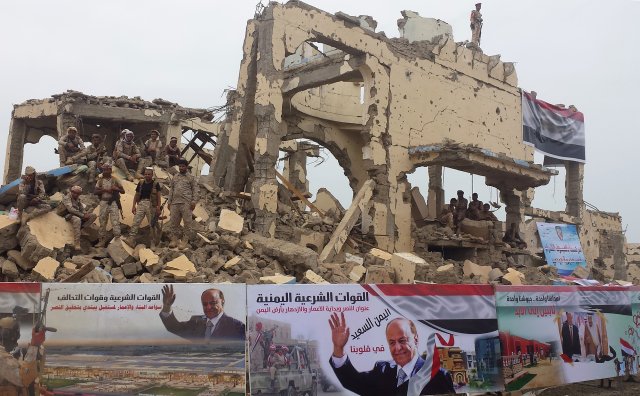Yemeni fighters loyal to the Saudi-backed President Hadi (portrait) gather above debris of a building in the area of Yemen’s northern coastal town of Midi, located in conflict-ridden Hajjah governorate near the border with Saudi Arabia, on April 22, 2019. Anuj Chopra/AFP
The Stockholm Agreement is the first agreement achieved between President Hadi’s internationally recognised government and the Huthi movement since the internationalised war started in early 2015. After a series of failed negotiations in the first year of the war, no meetings took place between the two parties for 27 months, and this one only happened as a result of very considerable international pressure. Of its three elements, only two deserve mention 13 months later: the proposed exchange of 16 000 prisoners has failed to happen though a few hundred were exchanged in recent months, including the liberation of a number of Saudi military held by the Huthis. These exchanges have taken place through tribal mediation and outside of the UN framework, though the Red Cross has been involved.
The Hodeida element of this agreement has met a marginally better fate: although the cease-fire in the governorate is increasingly being breached, Hodeida City itself has seen a remarkable decrease in conflict, and the UN Mission for the Hodeida Agreement (UNMHA) has deployed observers in five crucial locations in and around the city itself. The redeployment of forces has largely been a cosmetic operation with no substantive withdrawal of Huthi forces from the three ports concerned. More recent “agreements” reached under its auspices are, to date, unimplemented. UNSC renewal of the mandate of the UNMHA for 6 months, till mid-July 2020, is likely to ensure that the situation in Hodeida does not deteriorate during this period.
Unfortunately, the same cannot be said for other aspects of the Yemeni crisis. Just to get these out of the way, other military fronts between the Huthis and their opponents remained practically unchanged throughout 2019. The only area where there has been (largely static) action is Dhala’ where the Huthis have confronted southern forces; close examination of this front further demonstrates the extraordinary relationship between different anti-Huthi elements: while the southern separatist STC forces are protecting the old YAR-PDRY borders, fighting within the former YAR region is being done by Hadi’s forces, without support from their STC “partners!”
Dramatic humanitarian situation
For the record, the humanitarian situation was largely unchanged throughout 2019, with millions dependent on humanitarian aid, as government salary payments of 1.2 million civil staff remained at their totally inadequate level, amounting at best to half a month’s salary roughly every quarter throughout the country. While it is clear that the financial blockade against the Huthis explains the situation in the areas under their control, the situation should, in principle, be far better in the “liberated” areas where substantial Saudi and Emirati funds are available, raising the question of what has happened to these funds.
As was the case a year ago, about 24 million Yemenis are believed to be in need of humanitarian assistance of some kind, ranging from water, sanitation, nutrition to health services. Medically, the cholera crisis has again peaked in 2019, with close to 900,000 cases in the first 10 months of the year (data for the full year not yet available), by comparison with less than 300 000 cases in the whole of 2018. In addition a new dengue fever outbreak started in 2019, let alone the psychological damage caused by the war. Overall Yemenis of all ages are increasingly traumatised and weakened thus susceptible to diseases due to years of inadequate nutrition and health care. This, of course, is worse for the most vulnerable, namely young children, the elderly and pregnant or lactating women. There are also clear locality based differences in the situation, with the non-Huthi areas having greater access to humanitarian assistance from the main coalition members, Saudi Arabia and the UAE.
The Riyadh Agreement, unrealistic and little respected
This brings us to the second agreement, the Riyadh Agreement signed on 5 November 2019 by the internationally recognised government and the STC. In August 2019 the STC expelled militarily the IRG from its official interim capital Aden. Open conflict between these two essential components of the anti-Huthi coalition presents a fundamental threat to the coalition and president Hadi’s government: losing control of its capital reduced it to being little more than a government-in-exile, regardless of the fact that many of its senior members have been based in Riyadh, capital of Saudi Arabia, most of the time since they were expelled from Yemen’s capital Sana’a in 2015.
Taking place a few weeks after the UAE announced its complete withdrawal from the Yemeni war, this event compelled Saudi Arabia to intervene directly. Immediately announcing discussions in Jedda between the two protagonists, and backed by statements of support from the UAE, it still took more than three months to achieve the signature of the Riyadh Agreement between representatives of Hadi’s government and those of the STC.
The main elements of this agreement are the removal of all armed elements and their equipment from the cities, the integration of all military and security personnel into the official coalition forces under the authority of the ministries of Defence and Interior respectively and the formation of a new government of no more than 24 members including 50% southerners [there are more than 50% southerners in the current government]. Most importantly, all state income is to be managed through the Aden-based Central Bank of Yemen (CBY) which is to be accountable to the parliament.
The agreement is to be implemented according to a strict timetable: two months into the period, nothing has been done on time, and the only activity carried out is the return to Aden of the Prime Minister and other senior officials concerned with finance, who were explicitly mandated to ensure the payment of salaries to security staff, something which remains an outstanding issue. The temporary kidnapping of 4 containers full of new cash by the STC on 1 January raises many questions, but may have been a hint to the government to pay salaries to their forces.
Historical roots of the conflict
Meanwhile, no other ministers have returned to Aden and clashes between the STC and government sides have taken place sporadically on what are effective front lines between them in Abyan and Shabwa, with both sides consolidating their positions. At a glance, the current fronts identify the areas controlled by each side and, in particular, confirm the limits of STC influence to the area of origin of its leaders (Dhala district, most of central and eastern Lahej and the western coastal strips of Abyan). They are the areas of origin of the leaders of the “victorious” faction in the internecine 1986 clashes within the Yemeni Socialist Party prior to unification. The rest of Abyan and most of Shabwa are under government control, its main figures including President Hadi, were members of the defeated faction in 1986. This clearly reveals the historic roots and factionalist nature of these allegiances and incidentally demonstrates that the STC’s claim to represent the whole South is far from accurate.
With respect to the implementation of the Riyadh Agreement, two months after the signature, the situation is hardly encouraging. In addition to the above-mentioned clashes and stalemate, the STC has now withdrawn from its implementation committees. Moreover, its clauses are to be carried out under the supervision and monitoring of a coalition committee which, given UAE withdrawal, means a Saudi committee. This raises concerns about the sovereignty of the Yemeni state and its IRG, and is reminiscent of the authority given to the Gulf Cooperation Council Agreement of 2011, which was one of the steps leading to the disintegration of the country. A basic requirement for success will be the UAE’s willingness to suspend its direct practical support for the STC, on which the latter has depended financially, materially and diplomatically since its establishment in 2017.
In addition to the problems intrinsic to the nature of the agreement, the following are worth noting: first it is only between the government and the STC and ignores the other southern separatist organisations, let alone any other issues whether political, social or economic; second, the governorates which have achieved significant control over their mainly oil-related income, namely Mareb, Hadhramaut and Shabwa, are unlikely to appreciate the suggestion that they should hand over all income to the Aden CBY. Third, the numerous separatist groups involved in Aden have, up to now, prevented the parliament from meeting there: the only meeting held was in Seiyun in April 2019. Overall the Riyadh Agreement shares characteristics with earlier Yemeni agreements: a combination of imprecise implementation mechanisms, unrealistic deadlines and idealistic sequencing.
International pressure failed
While the UN has only been involved in the Stockholm agreement, its current and possible role deserves mention here. It is now clear that this agreement, rather than bring the UN and its Special Envoy (UNSE) into the heart of the Yemeni crisis, has had the opposite effect. Given UN failure on prisoner exchange and Taiz, its partial success in Hodeida has marginalised the UNSE largely because of his “single issue” approach.
Progress on the Huthi front has come about as a result of September 14 missile attack on Aramco facilities in Saudi Arabia which led the Saudi regime to realise that Trump’s US would not rescue it from any threat. The new Deputy Defence Minister, Khaled bin Salman, brother of the Crown Prince, is determined to get his country out of the quagmire of Yemen, and distance Saudi Arabia from the increasingly dangerous US-Iran confrontation. He has initiated direct discussions with the Huthis in Saudi Arabia and Oman, and will probably include the UN for cosmetic reasons to give international endorsement to any agreement which might be reached bilaterally.
In conclusion, both the Stockholm and the Riyadh Agreements are suffering major problems: neither addresses the most important issues faced by the Yemeni state or the Yemeni people; both are partial and focused on single issues, rather than seeking comprehensive solutions; both have been agreed under international, rather than internal pressure, and therefore respond to the needs of their sponsors rather than to those of the Yemenis. Neither is likely to achieve success in the course of 2020 without a fundamental change of approach from the warring parties, of which there is little sign.
The year may see a formal, or informal, end to international involvement in the fighting, but this is unlikely to be the end of Yemeni suffering, as the internal political and military struggle between multiple factions is likely to persist, particularly given the deep fragmentation and bitterness which have transformed the country in the past half decade. Without peace, the economy is unlikely to recover while social conditions and long-term development prospects continue their deterioration, and global warming worsens the already difficult objective development environment which Yemenis face.




